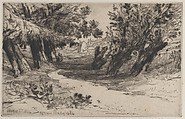The Lovers' Walk, No. 2
Sir Francis Seymour Haden British
Not on view
Seymour Haden was the unlikely combination of a surgeon and an etcher. Although he pursued a very successful medical career, he is mostly remembered for his etched work as well as for his writings on etching. He was one of a group of artists, including James McNeill Whistler (1834–1903) and Alphonse Legros (1837–1911), whose passionate interest in the medium led to the so-called etching revival, a period that lasted well into the twentieth century. The extolling of etching for its inherent spontaneous qualities reached its pinnacle during this time. While the line of the etching needle, Haden wrote, was "free, expressive, full of vivacity," that of the burin was "cold, constrained, uninteresting," and "without identity."
View of path flanked with trees and shadowing on either side; figures in the distance at left; foliage in foreground at left.
"State II (H1). The water behind the figures on left, before the mill, is shaded with drypoint. Additional work in foliage at plate center and between leftmost tree and the next on its right, and on the third tree. Additional work on reeds and foliage of clump of trees on right."
[Source: Schneiderman, p.169]
"Published State: First.-The bur in various parts of the plate is considerably reduced."
[Source: Harrington, p. 35]
Due to rights restrictions, this image cannot be enlarged, viewed at full screen, or downloaded.


